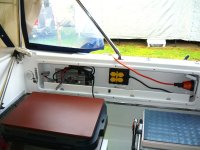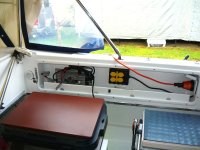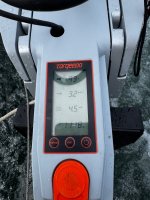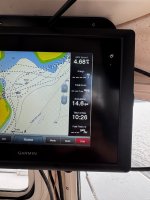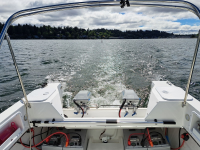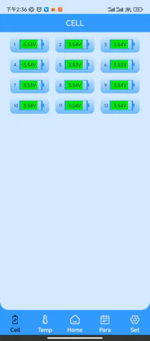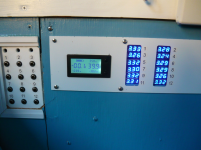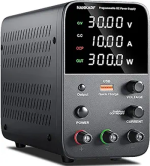Tom Hruby
Member
- Joined
- Nov 11, 2023
- Messages
- 183
- Reaction score
- 18
- C Dory Year
- 2024
- C Dory Model
- 22 Cruiser
- Vessel Name
- WATT NOW
Now that the boat is on its trailer for the winter I wanted to pass on notes to for those interested in converting to electric propulsion.
1. The four 48V 100AH batteries (in two banks) are charged by a 20A charger I placed in the "shelf" in the cockpit. I have found that chargers in a boat need to be at least IP66 rated. The one I have is IP 67. Chargers that have internal fans rather than exterior heat sinks fail within a year because of humidity even if they are in a cabin.
The charger plugs into an exterior grade power supply I wired into the "spare" circuit in the power panel installed under the starboard seat. Since I have two battery banks I plug each one separately into the charger using a 50A Anderson Plug. Wires from the charger to the batteries is 10 gauge. I have posted a photo in my album (WATT NOW) The red power cord is the 120 V line coming in from the shore power in our RV lot.
I have also added solar panels and the charge controllers are in the other shelf on the starboard side. I have two separate panels, one for each battery bank. The panels need to be manually plugged into the controllers so there is no chance of accidentally charging using both solar and shore power at the same time. Photo also added to album. The white box in front holds my Dometic fridge. [/img]
1. The four 48V 100AH batteries (in two banks) are charged by a 20A charger I placed in the "shelf" in the cockpit. I have found that chargers in a boat need to be at least IP66 rated. The one I have is IP 67. Chargers that have internal fans rather than exterior heat sinks fail within a year because of humidity even if they are in a cabin.
The charger plugs into an exterior grade power supply I wired into the "spare" circuit in the power panel installed under the starboard seat. Since I have two battery banks I plug each one separately into the charger using a 50A Anderson Plug. Wires from the charger to the batteries is 10 gauge. I have posted a photo in my album (WATT NOW) The red power cord is the 120 V line coming in from the shore power in our RV lot.
I have also added solar panels and the charge controllers are in the other shelf on the starboard side. I have two separate panels, one for each battery bank. The panels need to be manually plugged into the controllers so there is no chance of accidentally charging using both solar and shore power at the same time. Photo also added to album. The white box in front holds my Dometic fridge. [/img]

